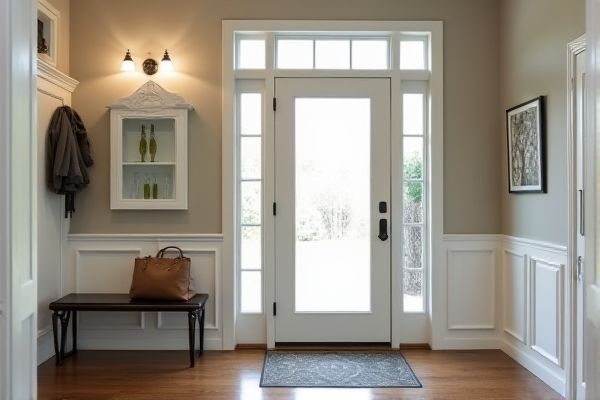
A mudroom Dutch door offers enhanced ventilation and light control by splitting into two separate panels, allowing you to open the top while keeping the bottom closed to keep dirt and pets contained. Explore the differences and benefits in this article to determine which door style best suits your home's needs.
Table of Comparison
| Feature | Mudroom Dutch Door | Standard Door |
|---|---|---|
| Design | Split horizontally into two panels | Single solid panel |
| Ventilation | Allows air flow without full opening | Only full door opening |
| Safety | Top half can remain closed to keep children/pets inside | No partial closure option |
| Light | Top panel can include window for natural light | Varies; often solid or full glass |
| Usage | Ideal for mudrooms, entryways, kitchens | General purpose, all room entries |
| Maintenance | More moving parts, potentially higher upkeep | Simple, low maintenance |
| Cost | Typically higher due to design complexity | Generally lower |
Introduction to Mudroom Door Options
Mudroom door options include Dutch doors and standard doors, each offering distinct functionality and style. Dutch doors split horizontally, allowing the top half to open independently for ventilation while keeping the bottom half closed, ideal for managing pets and kids. Your choice depends on space, ventilation needs, and aesthetic preferences, making Dutch doors a versatile option compared to traditional single-panel standard doors.
What is a Dutch Door?
A Dutch door, also known as a stable door or half door, is divided horizontally, allowing the top half to open independently from the bottom half. This design provides enhanced ventilation and light while maintaining security and containment for pets or children. Unlike a standard door that opens as a single unit, a Dutch door offers versatile functionality and aesthetic charm in mudroom applications.
Overview of Standard Mudroom Doors
Standard mudroom doors typically feature solid construction with durable materials such as wood or fiberglass, designed to withstand heavy indoor-outdoor traffic and protect the home from dirt and moisture. These doors often include weather-resistant seals and easy-to-clean surfaces, making them ideal for muddy or wet conditions commonly encountered in mudrooms. Your choice between a standard door and a Dutch door will affect ventilation, accessibility, and the ease of managing pets or children in the space.
Aesthetic Appeal: Dutch Door vs Standard Door
Dutch doors enhance your mudroom's aesthetic appeal with their charming, rustic design and split functionality, offering a unique visual interest compared to the simple, solid look of standard doors. The top half of a Dutch door can remain open, allowing light and ventilation while maintaining separation, which adds character and warmth to the space. Standard doors, while sleek and versatile, often lack the distinctive style elements that make Dutch doors a focal point in mudroom decor.
Functionality and Practical Uses
A mudroom Dutch door enhances functionality by allowing the top half to open independently, providing ventilation and light while keeping pets or children safely inside. Unlike a standard door that swings open completely, the Dutch door's split design offers practical uses such as easy transfer of items without fully opening the entry, reducing dirt and debris tracked indoors. Your mudroom benefits from this versatile door by balancing accessibility, security, and cleanliness in a compact space.
Ventilation and Natural Light Benefits
A Dutch door in a mudroom enhances ventilation by allowing the top half to open independently, promoting airflow while keeping pets or children safe inside. This design increases natural light penetration compared to a standard solid door, brightening the space without compromising privacy. Improved ventilation and light contribute to a healthier, more inviting mudroom environment.
Security Considerations
Mudroom Dutch doors offer enhanced security through their split design, allowing homeowners to lock the bottom half while keeping the top half open for ventilation or communication without full access. Standard doors provide a single locking mechanism, which may be simpler but lack the versatility of partial openness without compromising security. The double-locking options in Dutch doors improve protection against forced entry compared to traditional full-panel doors.
Maintenance and Durability
Mudroom Dutch doors offer enhanced durability with their split design, allowing only the top half to be opened for ventilation while keeping the bottom half closed, reducing wear and tear from frequent use. Standard doors generally require more maintenance as the entire door experiences constant stress and may be more prone to warping or damage in high-traffic mudroom areas. Your choice of a Dutch door can lead to lower maintenance costs and longer-lasting performance in busy entry spaces.
Cost Comparison: Dutch Door vs Standard Door
A Dutch door typically costs 20-30% more than a standard door due to its split design and additional hardware requirements. Standard doors average between $100 and $300, while Dutch doors range from $150 to $450, influenced by materials and customization. Installation expenses for Dutch doors are also higher, reflecting their complexity compared to simpler standard door fittings.
Choosing the Best Mudroom Door for Your Home
Selecting the best mudroom door for your home requires comparing a Dutch door's split design, which allows for separate opening of the top and bottom halves, with a standard door's full-panel functionality that offers simplicity and security. Dutch doors enhance ventilation and light control while providing a charming, rustic aesthetic ideal for busy households with pets or children. Your choice depends on balancing practicality, style preference, and how much natural airflow or interaction you want between your mudroom and the adjoining space.
 homyna.com
homyna.com